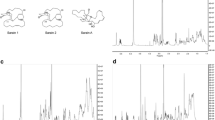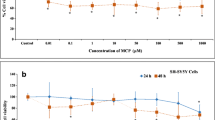Abstract
The involvement of copper in the pathophysiology of neurodegenerative disorders has been documented but remains poorly understood. This study aimed at investigating the molecular mechanism underlying copper-induced neurotoxicity. Human neuroblastoma SH-SY5Y cells were treated with different concentrations of Cu(II) (25–800 μM). The relative levels of AMPKα, phosphorylated (p)-AMPKα were examined by western blotting. The results showed that copper reduced cell viability and enhanced apoptosis of SH-SY5Y cells. Pretreatment with N-acetyl-l-cysteine, a common ROS scavenger, decreased copper-induced cytotoxicity. Furthermore, the levels of p-AMPKα in SH-SY5Y cells were increased by a relatively low concentration of copper and decreased by a relatively high concentration of copper at 24 h. Moreover, inhibition of AMPK with compound C or RNA interference aggravated concentration-dependent cytotoxicity of Cu(II). Taken together, these results indicated that AMPK activity might be important for the neurotoxicity of Cu(II).









Similar content being viewed by others
References
Ahmed SS, Santosh W (2010) Metallomic profiling and linkage map analysis of early Parkinson’s disease: a new insight to aluminum marker for the possible diagnosis. PLoS ONE 5:e11252
An JY, Zhou LL, Sun P, Pang HG, Li DD, Li Y, Zhang M, Song JN (2015) Role of the AMPK signaling pathway in early brain injury after subarachnoid hemorrhage in rats. Acta Neurochir 157:781–792
Anandhan A, Rodriguez-Rocha H, Bohovych I, Griggs AM, Zavala-Flores L, Reyes-Reyes EM, Seravalli J, Stanciu LA, Lee J, Rochet JC, Khalimonchuk O, Franco R (2015) Overexpression of alpha-synuclein at non-toxic levels increases dopaminergic cell death induced by copper exposure via modulation of protein degradation pathways. Neurobiol Dis 81:76–92
Armstrong C, Leong W, Lees GJ (2001) Comparative effects of metal chelating agents on the neuronal cytotoxicity induced by copper (Cu+2), iron (Fe+3) and zinc in the hippocampus. Brain Res 892:51–62
Bonda DJ, Lee HG, Blair JA, Zhu X, Perry G, Smith MA (2011) Role of metal dyshomeostasis in Alzheimer’s disease. Metallomics 3:267–270
Chen L, Xu B, Liu L, Luo Y, Zhou H, Chen W, Shen T, Han X, Kontos CD, Huang S (2011a) Cadmium induction of reactive oxygen species activates the mTOR pathway, leading to neuronal cell death. Free Radic Biol Med 50:624–632
Chen MB, Shen WX, Yang Y, Wu XY, Gu JH, Lu PH (2011b) Activation of AMP-activated protein kinase is involved in vincristine-induced cell apoptosis in B16 melanoma cell. J Cell Physiol 226:1915–1925
Chen MB, Wu XY, Gu JH, Guo QT, Shen WX, Lu PH (2011c) Activation of AMP-activated protein kinase contributes to doxorubicin-induced cell death and apoptosis in cultured myocardial H9c2 cells. Cell Biochem Biophys 60:311–322
Culmsee C, Monnig J, Kemp BE, Mattson MP (2001) AMP-activated protein kinase is highly expressed in neurons in the developing rat brain and promotes neuronal survival following glucose deprivation. J Mol Neurosci 17:45–58
Dasgupta B, Milbrandt J (2007) Resveratrol stimulates AMP kinase activity in neurons. Proc Natl Acad Sci USA 104:7217–7222
Filomeni G, Cardaci S, Da Costa Ferreira AM, Rotilio G, Ciriolo MR (2011) Metabolic oxidative stress elicited by the copper(II) complex [Cu(isaepy)2] triggers apoptosis in SH-SY5Y cells through the induction of the AMP-activated protein kinase/p38MAPK/p53 signalling axis: evidence for a combined use with 3-bromopyruvate in neuroblastoma treatment. Biochem J 437:443–453
Fogarty S, Hardie DG (2010) Development of protein kinase activators: AMPK as a target in metabolic disorders and cancer. Biochim Biophys Acta 1804:581–591
Gorell JM, Johnson CC, Rybicki BA, Peterson EL, Kortsha GX, Brown GG, Richardson RJ (1999) Occupational exposure to manganese, copper, lead, iron, mercury and zinc and the risk of Parkinson’s disease. Neurotoxicology 20:239–247
Hardi DG, Carling D, Carlson M (1998) The AMP-activated/SNF1 protein kinase subfamily: metabolic sensors of the eukaryotic cell? Annu Rev Biochem 67:821–855
Hardie DG (2003) Minireview: the AMP-activated protein kinase cascade: the key sensor of cellular energy status. Endocrinology 144:5179–5183
Hasegawa T, Kaneko F, Niwa Y (1992) Changes in lipid peroxide levels and activity of reactive oxygen scavenging enzymes in skin, serum and liver following UVB irradiation in mice. Life Sci 50:1893–1903
Horning MS, Blakemore LJ, Trombley PQ (2000) Endogenous mechanisms of neuroprotection: role of zinc, copper, and carnosine. Brain Res 852:56–61
Hozumi I, Hasegawa T, Honda A, Ozawa K, Hayashi Y, Hashimoto K, Yamada M, Koumura A, Sakurai T, Kimura A, Tanaka Y, Satoh M, Inuzuka T (2011) Patterns of levels of biological metals in CSF differ among neurodegenerative diseases. J Neurol Sci 303:95–99
Hu YL, DeLay M, Jahangiri A, Molinaro AM, Rose SD, Carbonell WS, Aghi MK (2012) Hypoxia-induced autophagy promotes tumor cell survival and adaptation to antiangiogenic treatment in glioblastoma. Cancer Res 72:1773–1783
Hwang JT, Ha J, Park OJ (2005) Combination of 5-fluorouracil and genistein induces apoptosis synergistically in chemo-resistant cancer cells through the modulation of AMPK and COX-2 signaling pathways. Biochem Biophys Res Commun 332:433–440
Hwang JT, Ha J, Park IJ, Lee SK, Baik HW, Kim YM, Park OJ (2007) Apoptotic effect of EGCG in HT-29 colon cancer cells via AMPK signal pathway. Cancer Lett 247:115–121
Inoki K, Zhu T, Guan KL (2003) TSC2 mediates cellular energy response to control cell growth and survival. Cell 115:577–590
Inoki K, Kim J, Guan KL (2012) AMPK and mTOR in cellular energy homeostasis and drug targets. Annu Rev Pharmacol Toxicol 52:381–400
Jeon SM, Chandel NS, Hay N (2012) AMPK regulates NADPH homeostasis to promote tumour cell survival during energy stress. Nature 485:661–665
Johnson JJ (2011) Carnosol: a promising anti-cancer and anti-inflammatory agent. Cancer Lett 305:1–7
Kim T, Davis J, Zhang AJ, He X, Mathews ST (2009) Curcumin activates AMPK and suppresses gluconeogenic gene expression in hepatoma cells. Biochem Biophys Res Commun 388:377–382
Larner F, Sampson B, Rehkämper M, Weiss DJ, Dainty JR, O’Riordan S, Panetta T, Bain PG (2013) High precision isotope measurements reveal poor control of copper metabolism in parkinsonism. Metallomics 5:125–132
Lee M, Hwang JT, Lee HJ, Jung SN, Kang I, Chi SG, Kim SS, Ha J (2003) AMP-activated protein kinase activity is critical for hypoxia-inducible factor-1 transcriptional activity and its target gene expression under hypoxic conditions in DU145 cells. J Biol Chem 278:39653–39661
Letelier ME, Lepe AM, Faúndez M, Salazar J, Marín R, Aracena P, Speisky H (2005) Possible mechanisms underlying copper-induced damage in biological membranes leading to cellular toxicity. Chem Biol Interact 151:71–82
Levenson CW (2005) Trace metal regulation of neuronal apoptosis: from genes to behavior. Physiol Behav 86:399–406
Li KR, Zhang ZQ, Yao J, Zhao YX, Duan J, Cao C, Jiang Q (2013) Ginsenoside Rg-1 protects retinal pigment epithelium (RPE) cells from cobalt chloride (CoCl2) and hypoxia assaults. PLoS ONE 8:e84171
Linnebank M, Lutz H, Jarre E, Vielhaber S, Noelker C, Struys E, Jakobs C, Klockgether T, Evert BO, Kunz WS, Wüllner U (2006) Binding of copper is a mechanism of homocysteine toxicity leading to COX deficiency and apoptosis in primary neurons, PC12 and SHSY-5Y cells. Neurobiol Dis 23:725–730
Lu HR, Li SH, Chen J, Xia J, Zhang JC, Huang Y, Liu XX, Wu HC, Zhao YL, Chai ZF, Hu Y (2015) Metal ions modulate the conformation and stability of a G-quadruplex with or without a small-molecule ligand. Metallomics 7:1508–1514
Lu HR, Zhang HT, Chen J, Zhang JC, Liu RC, Sun HY, Zhao YL, Chai ZF, Hu Y (2016) A thiol fluorescent probe reveals the intricate modulation of cysteine’s reactivity by Cu(II). Talanta 146:477–482
Luo Z, Saha AK, Xiang X, Ruderman NB (2005) AMPK, the metabolic syndrome and cancer. Trends Pharmacol Sci 26:69–76
Mihaylova MM, Shaw RJ (2011) The AMPK signaling pathway coordinates cell growth, autophagy and metabolism. Nat Cell Biol 13:1016–1023
Miller EJ, Li J, Leng L, McDonald C, Atsumi T, Bucala R, Young LH (2008) Macrophage migration inhibitory factor stimulates AMP-activated protein kinase in the ischaemic heart. Nature 451:578–582
Ostrakhovitch EA, Cherian MG (2004) Differential regulation of signal transduction pathways in wild type and mutated p53 breast cancer epithelial cells by copper and zinc. Arch Biochem Biophys 423:351–361
Pall HS, Williams AC, Blake DR, Lunec J, Gutteridge JM, Hall M, Taylor A (1987) Raised cerebrospinal-fluid copper concentration in Parkinson’s disease. Lancet 2:238–241
Ramamurthy S, Ronnett GV (2006) Developing a head for energy sensing: AMP-activated protein kinase as a multifunctional metabolic sensor in the brain. J Physiol 574:85–93
Rocha GZ, Dias MM, Ropelle ER, Osório CF, Rossato FA, Vercesi AE, Saad MJ, Carvalheira JB (2011) Metformin amplifies chemotherapy-induced AMPK activation and antitumoral growth. Clin Cancer Res 17:3993–4005
Shaw RJ, Kosmatka M, Bardeesy N, Hurley RL, Witters LA, DePinho RA, Cantley LC (2004) The tumor suppressor LKB1 kinase directly activates AMP-activated kinase and regulates apoptosis in response to energy stress. Proc Natl Acad Sci USA 101:3329–3335
Sun H, Yu T, Li J (2011) Co-administration of perifosine with paclitaxel synergistically induces apoptosis in ovarian cancer cells: more than just AKT inhibition. Cancer Lett 310:118–128
Vucicevic L, Misirkic M, Janjetovic K, Harhaji-Trajkovic L, Prica M, Stevanovic D, Isenovic E, Sudar E, Sumarac-Dumanovic M, Micic D, Trajkovic V (2009) AMP-activated protein kinase-dependent and -independent mechanisms underlying in vitro antiglioma action of compound C. Biochem Pharmacol 77:1684–1693
Vucicevic L, Misirkic M, Janjetovic K, Vilimanovich U, Sudar E, Isenovic E, Prica M, Harhaji-Trajkovic L, Kravic-Stevovic T, Bumbasirevic V, Trajkovic V (2011) Compound C induces protective autophagy in cancer cells through AMPK inhibition-independent blockade of Akt/mTOR pathway. Autophagy 7:40–50
Yu WR, Jiang H, Wang J, Xie JX (2008) Copper (Cu2+) induces degeneration of dopaminergic neurons in the nigrostriatal system of rats. Neurosci Bull 24:73–78
Zhang WB, Wang Z, Shu F, Jin YH, Liu HY, Wang QJ, Yang Y (2010) Activation of AMP-activated protein kinase by temozolomide contributes to apoptosis in glioblastoma cells via p53 activation and mTORC1 inhibition. J Biol Chem 285:40461–40471
Zheng YS, Zhang JY, Zhang DH (2015) Fatsioside A-induced apoptotic death of HepG2 cells requires activation of AMP-activated protein kinase. Mol Med Rep 12:5679–5984
Acknowledgments
This study was supported by the National Natural Science Foundation of China (Grant Nos. 11375213 and 21390411) and Hundred Talents Program of the Chinese Academy of Sciences.
Author information
Authors and Affiliations
Corresponding author
Ethics declarations
Conflict of interest
The authors declare that they have no competing interests.
Rights and permissions
About this article
Cite this article
Lan, Ap., Xiong, Xj., Chen, J. et al. AMPK Inhibition Enhances the Neurotoxicity of Cu(II) in SH-SY5Y Cells. Neurotox Res 30, 499–509 (2016). https://doi.org/10.1007/s12640-016-9651-3
Received:
Revised:
Accepted:
Published:
Issue Date:
DOI: https://doi.org/10.1007/s12640-016-9651-3




